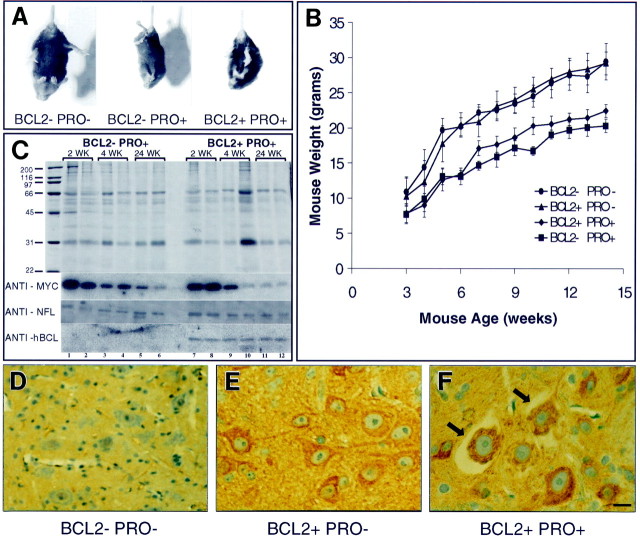Fig. 1.
Mutant mice are easily identified by retracted limb posture and decreased weight. A, Wild-type mice (left) extend their hindlimbs when held by the tail, whereas mutant NF-L (Pro) mice with either normal (middle) or increased (right) levels of Bcl-2 retract their hindlimbs. Mice shown are 1-month-old littermates.B, Overexpression of Bcl-2 (▴) does not drastically alter the body weight of mice when compared with that of wild-type littermates (●). Overexpression of Bcl-2 in mutant NF-L (Pro) mice (♦) slightly increases the body weight of mice over that of singly transgenic NF-L (Pro) mice (▪) at most ages.Points represent averages from four mice from each genotype. Error bars represent the SEM. C, Total sciatic nerve homogenates from 2-, 4-, and 24-week-old mice from NF-L (Pro) mice and doubly transgenic NF-L (Pro)/Bcl-2 mice were resolved on an 11% Coomassie blue–stained polyacrylamide gel. Two mice from each age are shown in adjacent lanes. Parallel gels were used for immunoblotting. Molecular weight markers are shown on theleft. Levels of myc-tagged NF-L transgene in the sciatic nerves of NF-L (Pro) [lanes 1–6 (lane 1 to the right of the molecular weight markers)] and doubly transgenic NF-L (Pro)/Bcl-2 (lanes 7–12) mice are shown. Levels of endogenous mouse NF-L in the sciatic nerves of mutant NF-L (Pro) (lanes 1–6) and doubly transgenic NF-L (Pro)/Bcl-2 (lanes 7–12) mice of each age are shown. Levels of human Bcl-2 (hBCL) transgene protein in the sciatic nerves of mutant NF-L (Pro) (lanes 1–6) and doubly transgenic NF-L (Pro)/Bcl-2 (lanes 7–12) mice of each age are shown.D–F, Immunocytochemical detection of the human Bcl-2 transgene product in the ventral spinal cord of 3-week-old mice is shown. Bcl-2−/NF-L (Pro)− mice (D), Bcl-2+/NF-L (Pro)− (E), and Bcl-2+/NF-L (Pro)+ (F) mice are shown. Bcl-2+/NF-L (Pro)+ cell bodies undergoing degeneration also contain the human Bcl-2 transgene product (arrows). Scale bar, 30 μm. BCLand BCL2, Bcl-2; PRO, NF-L (Pro).

